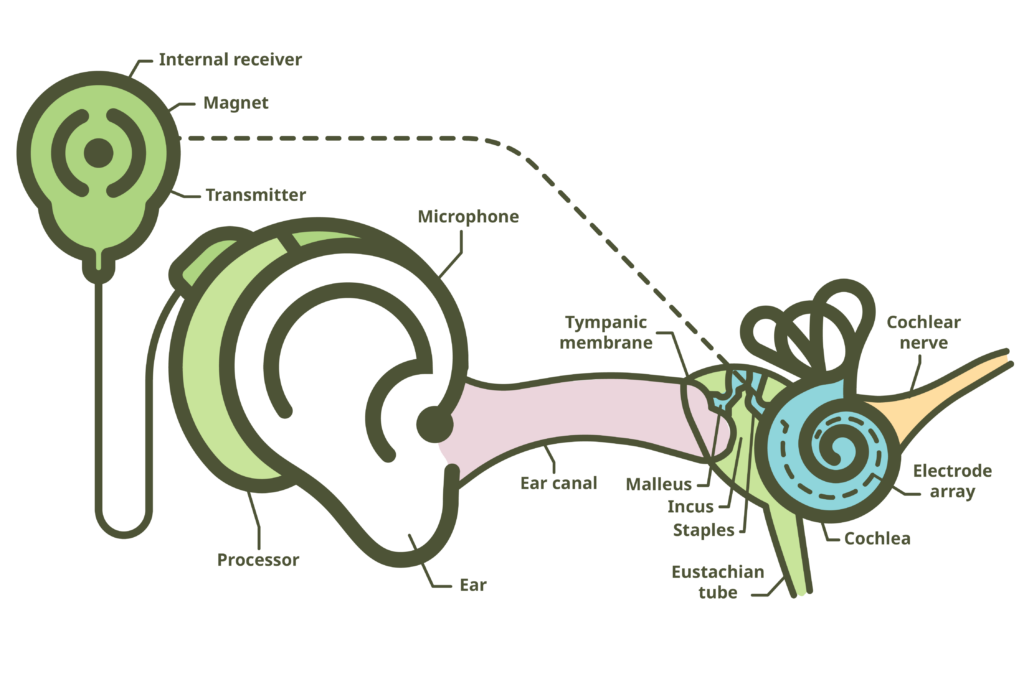If you have severe to profound hearing loss in both ears and aren’t benefiting from hearing aids, cochlear implants can improve your ability to hear and understand speech. This can help you communicate more confidently.
Cochlear implants provide a sensation of hearing to those who have severe to profound hearing loss.
Instead of making the sound louder, like a hearing aid, cochlear implants use electrical signals to directly stimulate the auditory nerve. The auditory nerve carries sound information from the cochlea to the brain. This direct stimulation bypasses damaged parts of the cochlear (the organ of hearing) that are not working.
The aim is to provide access to speech sounds. Results vary depending on the person and range from an awareness of environmental sounds to hearing speech. cochlear implants do not bring back normal hearing.
How cochlear implants work
Cochlear implants have several different parts, some of which are external (worn on the body) and some of which are internal (cannot be seen).
The external part consists of a microphone and a sound processor with a transmitter coil. The microphone picks up sounds, which are then processed into electrical signals. These are sent by the transmitter through the skin, via radio waves, to the internal part.
The internal part consists of a receiver that is fitted under the skin behind the ear, and an electrode array. The receiver picks up the radio wave signals sent through the skin by the transmitter. These are passed on down the electrode array. The electrode array is like a wire that carries the electrical signals into the cochlea, stimulating the auditory nerve. This gives the sensation of hearing.

The external part can vary in how it looks, depending on the make and model of the device. Typically, the microphone and processor look like a hearing aid which sits on the ear. There is small cable linking this to the transmitter which is held in place by a magnet behind the ear. This external part can be switched off and removed, for example when sleeping.
The internal part is surgically fitted under the skin and cannot be seen. This requires an operation.
Who can benefit from cochlear implants
If you have severe to profound deafness and want to find out whether a cochlear implant could help you, your GP, audiologist (hearing specialist), or your ear, nose and throat (ENT) specialist can refer you to a cochlear implant centre for an assessment.
Case study: Tasha Ghouri
Tasha Ghouri is a dancer and model, and was Love Island’s first deaf contestant. Tasha has been wearing a cochlear implant since the age of 5. We asked Tasha to share her experience of living with a cochlear implant (CI) for National Cochlear Implant Day.
RNID cochlear implant research
In the 1980s, RNID’s Technology team developed the first cochlear implant to be used in the UK, working with surgeons at the Royal National Ear, Nose and Throat Hospital in London. The first person to be given a cochlear implant in the UK received it in 1989. Now, around 20,000 people in the UK have a cochlear implant.
Today we are funding research to improve the technology for cochlear implants and to make sure more people benefit from them.
The research focuses on:
- demonstrating the benefits of cochlear implants
- refining the methods used to determine whether someone is suitable for an implant
- finding ways to improve how cochlear implant users hear speech, especially in noisy environments
- developing rehabilitation tools, such as training programmes, to help people learn to interpret the sounds they hear through their implant.
You can read more about the projects we are currently funding below:
- Dr Bob Carlyon is working to understand the changes that happen in the brain after someone receives a cochlear implant.
- Filip Hrncirik is focussing his PhD on finding ways to reduce damage to the inner ear during cochlear implant surgery.
To find out more about the research we fund, visit our biomedical research section.
Sign up to our newsletter
To see and support our work that improves the lives of people who are deaf or have hearing loss, keep in touch via our newsletter: